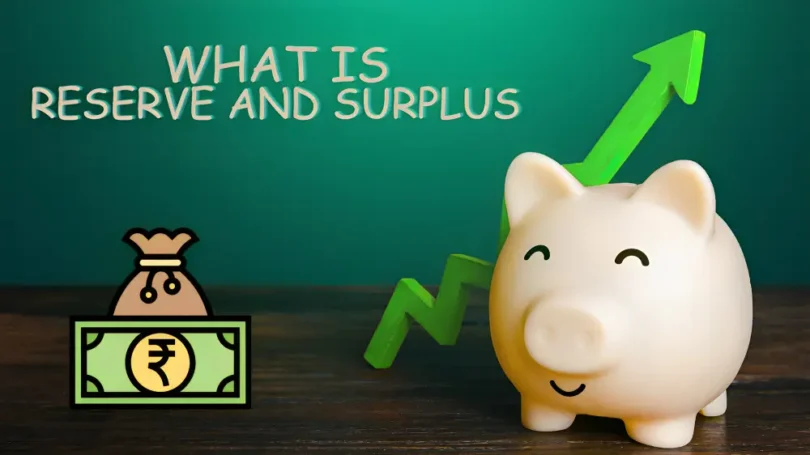Reserve and Surplus must have been listed on any company’s balance sheet if you have ever seen one. Any company’s reserve and surplus must be considered when doing an analysis. As a result, today’s post will provide a thorough understanding of What is reserve and surplus. including its meaning and what is known about it, among other things.
Reserve and Surplus Meaning
A company’s reserves and surplus are the funds it keeps on hand. This is kept as equity owned by shareholders. Reserves and excess are thus displayed in the shareholders’ equity section. Any business can build reserves and surplus to cover unforeseen expenses, settle debt, pay dividends, and acquire fixed assets. Businesses build up reserves and excess every year. As a result, it can rise or fall.
Reserve and Surplus Meaning with Example
Every company accumulates reserves by reserving a percentage of its profits, which it then utilizes to pay for unforeseen costs. To help us understand What is reserve and surplus, let’s look at an example.
Let us consider a scenario where a business has ₹1 lakh in initial reserves. In the meantime, the company used their ₹5 lakh earnings to deposit ₹50,000 into the Reserve and Surplus Account.
In this way, the company’s Reserve and Surplus Account will have ₹ 1,50,000 in it at the end of the year. The reserve history of Asian Paints can be seen by looking at the above chart. The company’s reserves have increased annually, which is quite remarkable in this regard.
After understanding What is reserve and surplus, let’s understand the process of Calculating company reserves.
How to Calculate Company Reserves?
However, there are other ways to determine a company’s reserves. Still, there are a few noteworthy methods that we are aware of.
- Reserve Formula: General Reserve = Opening General Reserve + Transfer to General Reserve
- Reserve and Surplus Formula: Reserve and Surplus = General Reserve + Capital Reserve + Surplus
- Surplus Formula: Surplus = Opening Surplus + (Net Profit – Transfer to General Reserve – Transfer to Dividend Reserve)
Types of Reserve and Surplus
The account that maintains the amount of profits is the surplus, out of reserves and surplus. There is no kind of it as a result. However, reserves are further separated into four main categories.
- General Reserve: Companies create this form of reserve by using the excess available to meet their obligations for an unknown or specified future. It is created by setting aside a portion of a company’s profits and is also known as a revenue reserve.
- Capital Reserve: A business establishes this type of reserve for specific purposes, including financing capital expenditures. Usually, this reserve is financed by the proceeds from the company’s other activities.
- Capital Redemption Reserve: Businesses typically use their gains that haven’t been distributed from their general reserve to construct this reserve. Repurchasing equity shares is this reserve’s primary goal.
- Dividend Reserve: This type of reserve exists in the form of a separate business account. The company uses it to give its shareholders dividend payments.
Companies thus set aside money for various uses.
Benefits of Creating a Reserve
This kind of reserve is present as a distinct business account. It is how the corporation pays dividends to its shareholders.
- Financial Security: Reserves help every business prepare for unanticipated difficulties and emergencies. This provides the company with financial stability by allowing it to meet its cash flow requirements, make investments, and purchase equipment and real estate.
- Reinvestment: The corporation has funds for its planned projects because of its reserves. Because of this, reserves are considered crucial to the company’s expansion and improvement.
- Improvement in Image (Credibility): Strong reserves improve the business’s standing. The business promotes investing among its patrons.
- Dividend Distribution: The company might use the reserves to pay dividends, which would increase owner profit and satisfy shareholders.
- Working Capital Maintenance: The corporation can easily meet its working capital requirements if its reserves are healthy. As a result, the business can avoid taking out loans for minor projects.
The company and the shareholders both gain from setting aside money for reserves.
Disadvantage of Reserve
The following are some disadvantages of setting up a reserve, albeit it also has many advantages:
- If the reserves are not used occasionally, the company will not benefit.
- A larger reserve can mean a lower dividend payment to shareholders.
- Because a reserve is never established with a particular purpose, its utilization is never guaranteed.
How to Use Reserve and Surplus?
You should consider the company’s reserves before selecting any share. However, based solely on a company’s strong reserves, you shouldn’t choose to invest in it. since choosing stocks involves several factors.
You need to look at the reserves and surplus on the balance sheet of the company you are researching. The reserves of the corporation are regarded as getting better over time.
Many businesses cause losses, and you can find reserves in these as well. However, a corporation that is losing money will never have stable reserves.
Conclusion
Financial analysts must understand What is a reserve and surplus? money since they are crucial markers of a company’s financial stability and strategic planning. Earnings are directed toward accumulating reserves, which are then utilized for a variety of purposes, including dividend payments and unexpected expenses.
In the computed reserve, each of the four reserves—general, capital, redemption, and dividend—has a specific function. Reserves can provide benefits like dividend stability and reinvestment opportunities, but they can also have disadvantages like potential payout cutbacks. Investors should carefully review a company’s reserves because they are a key component of credibility and long-term profitability.








Leave a Comment